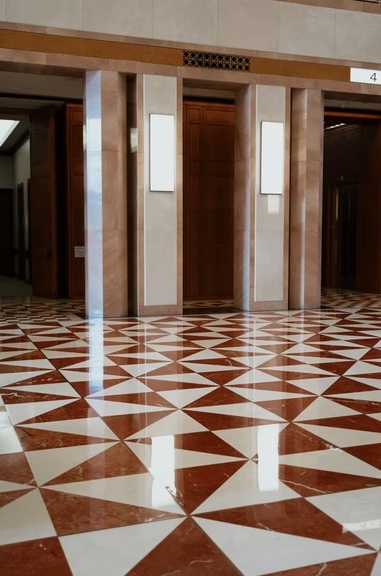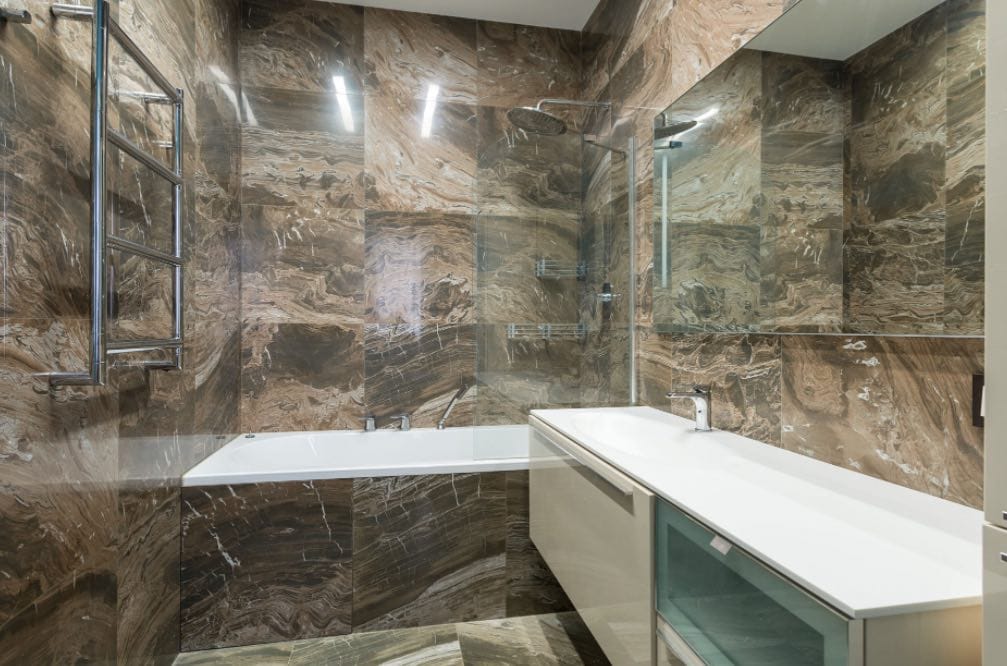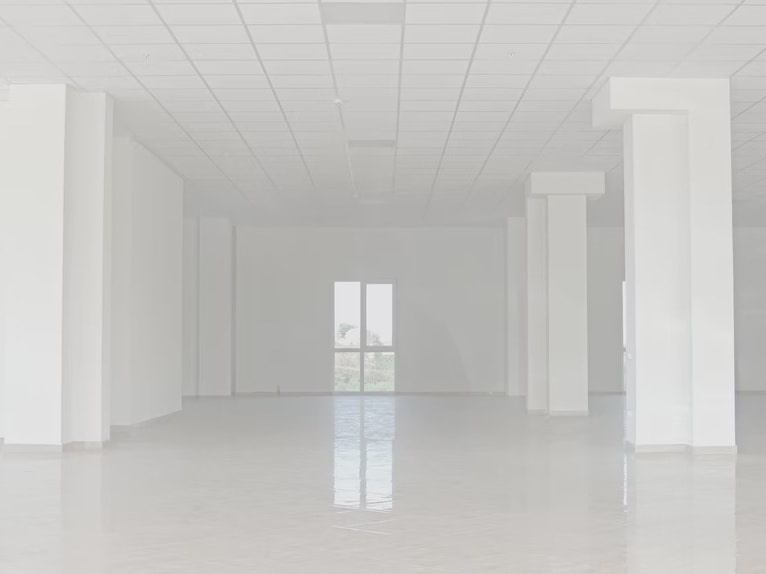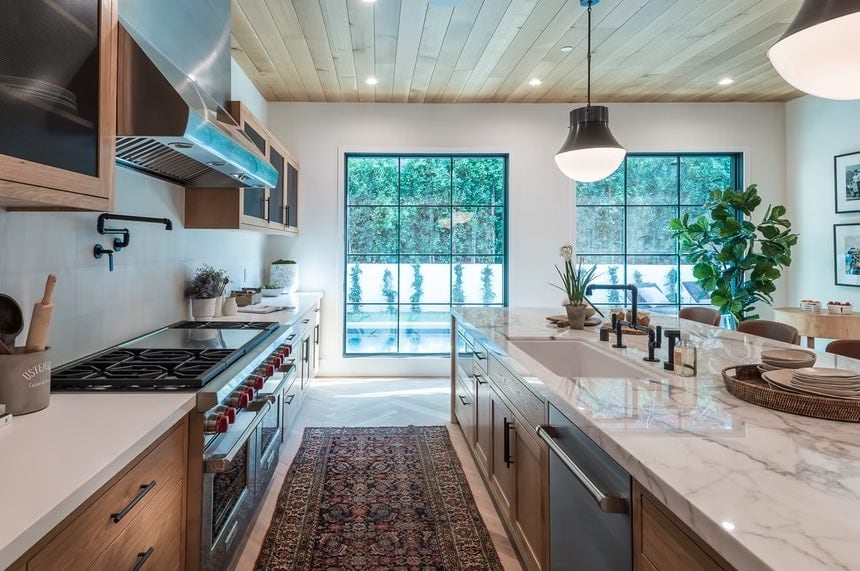If you’ve got marble floors in your home, you know how beautiful they look when they’re freshly cleaned and polished. Your floors should last a lifetime, but despite marble’s durability, they can be prone to damage if you clean them with the wrong solution or chemicals.
Having your marble professionally polished is fantastic, but it can be expensive. The results, of course, are magnificent in most cases. That’s because an expert in this field is a craftsman, highly trained in the use of various polishing processes incorporating specialised marble polishing compounds, chemicals, diamonds, pads and machinery. A marble polishing professional can remove deep scratches, repair damage and make a stone floor or surface look like new again. This expertise is highly valued and admired. It will always be a service that is important and in high demand.
There’s nothing more elegant than marble, a timeless material available in various colours and veining styles that make fabulous flooring. However, this delicate, porous stone is notorious for its susceptibility to stains—and only certain cleaning agents can be used on it without causing damage. So how’s a homeowner to keep them looking brand new? If you’re curious about how to clean marble floors in your own home, keep reading for all the tips you’ll need, from routine care to stain removal.
However, there are times when you just want to improve a marble floor with your in-house facility maintenance staff. For example, you might be on a strict budget, or you want to lengthen the time interval between professional restoration services. Maybe the marble floor is looking a little dull and tired and needs a lift. Just buffing the floor is not getting any improvement in the look of the floor anymore.
What Is Marble?
Under intense heat and pressure in the earth’s core, limestone breaks down and reforms into marble, which gets its beautiful appearance from how the limestone recrystallises. Despite the enormous forces at work creating it, marble can be surprisingly fragile. Because it’s formed from high-alkali minerals, it’s very susceptible to acid. Even spilling some cranberry sauce on an unprotected marble surface can cause it to corrode.
Surface corrosion eats away at marble’s smooth surface and forms what’s known as an “etch.” This might look like a stain that doesn’t shift no matter how you scrub it, but a good way to tell the difference is to remember that stains are darker than the original colour, whereas etches are lighter. That’s because the etch hasn’t soaked into the surface of the marble but removed it. Etches are also easier to spot at an angle or under oblique lighting, whereas stains usually look the same no matter how you approach them.
Getting etches in your marble doesn’t mean it’s ruined forever. You can buy stone cleaning powder, buff out minor etches and scratches, or call a professional to refinish your floor if the damage is very serious.
The best way to keep your marble looking pristine is damage prevention. Learn what can and can’t harm your marble floor and how to clean and treat it to keep it looking beautiful.
How To Polish A Marble Floor?
To maintain and care for your Marble Floor, you need to understand: Marble is a natural Lime Stone that has been transformed through heat, pressure and time—delivering a beautiful and durable building material that gives one of the most beautiful Floors coverings in the word. But, strong and Sturdy as it is, it is also very porous and stains easily.
Temperature method: lay your hand on the surface. Natural Marble is usually cooler to the touch than the surrounding air. Cultured marble will be about the same temperature as the surrounding air.
Acid method: Pick an inconspicuous area; put few drops of vinegar on the surface to be tested. If it is Natural Marble, you will see some bubbles or fizz, immediately wipe up the vinegar with a damp cloth to avoid damage.
Scratch method: In the same hidden spot, lightly scratch the surface with a nail. Use a magnifying glass to see if there is a visible scratch left. Natural Marble scratches easily, while cultured marble does not.
FAQs About Marble Floor
Is marble good for floors?
While marble is a durable flooring, it requires a little extra care to help it retain its beauty. Honed marble is more porous than polished marble, and it’s a good idea to seal a honed marble floor twice per year to help it resist staining. Use a mild, non-acidic floor cleaner for regular mopping.
Is marble flooring expensive?
High cost: Marble is one of the more expensive kitchen flooring materials on the market, and individual 12 x 12-inch tiles can cost upwards of $5 to $10 per square foot. The price can be even higher when dealing with designer mosaics, larger tiles, slabs, and non-standard sizes.
How long will marble flooring last?
Marble floors can last for more than three decades if you maintain them properly and regularly. These floors’ average life is around 25 years, but remember that they require love and care.

Natural Marble
Removing any existing stains. Marble is highly porous; stains are caused when liquid seeps into the stone and get trapped. Common spillages like juice, wine, sauces, cooking oils and coffee will all stain your marble surface. To remove fresh stains, use a Damp Microfiber Cloth with warm water and Neutral Detergent, gently rubbing the stain until the area is clean. Then rinse thoroughly.
Removing Stubborn Stains: Dampen marble with water, then apply a few drops of a cleaning chemical; we recommend using Sancitro. Next, gently rub in with a Stiff Bristle Brush and rinsing thoroughly; sometimes stubborn stains might require two or three applications.
Polishing: After stain removal is complete, Polishing makes sure you have a clean, dry surface as marble is soft and scratches easily, and you don’t want to damage it while polishing. Always use a clean, dry Microfiber cloth to remove any remaining dirt, dust and grit gently. If needed, rinse well with a clean, damp Microfiber cloth, then dry the surface well with a clean cloth.
Eco Polishing of your Marble: Use a mixture of Baking Soda and water as a polish. Combine (45 g) of baking soda to (0.9 L) of water and mix well. Then using a clean cloth, apply the mixture to your surface in a thin layer. Allow drying for about 5 hours. After which using a Microfiber Cloth and warm water to rinse the marble surface, you are now ready to dry buff the marble using a clean microfiber or chamois cloth, gently wipe down the marble in wide, circular motions. Move in progressively smaller circles as the surface dry.
Best Cleaning Equipment For Marble
Keep your marble floors clean and scratch-free by using the right equipment for the job. Avoid anything rough or sharp that can damage the marble’s sensitive surface. Soft materials such as chamois cloths and dust mops will protect your marble better than abrasive brushes and sponges. Dry erasers are particularly inadvisable because they work by irritating surfaces to clean them.
Never use vinegar, lemon juice, or other acidic cleaners on marble. Instead, stick with alkali cleaning solutions such as ammonia and hydrogen peroxide, or tepid water, to prevent the marble from reacting or etching.
Before you begin: Remember to keep the colour and exact makeup of your marble floor in mind when choosing cleaning solutions. Strong alkalis such as hydrogen peroxide and ammonia can bleach dark marble. Always test any cleaner on an inconspicuous area first. Whenever you’re cleaning marble, begin with a neutral solution such as water or a pH-balanced marble cleaner, and only use stronger solutions if necessary. When you’ve finished cleaning your marble floor, always flush the area with plain water to neutralise the pH of any residual chemicals, and dry thoroughly afterwards.
Cleaning Marble With a Dry Mop
Prevent abrasives like dirt and sand from scratching white marble floors by regularly cleaning them with a dust mop. Use a soft, natural, and chemical-free dust mop, and be sure to wash the mop head between uses. Avoid using a vacuum to clean up dust and dirt on marble because the vacuum’s wheels can easily scratch the floor.
How To Clean A Marble Floor?
Start cleaning your marble floors by preparing the surface thoroughly. Remove any dust or dirt carefully using a clean, dry cloth or a soft dust mop. Don’t drag the cloth or brush hard across the surface, or you run the risk of creating scratches on your floor. Even sand can scratch unfinished marble, so imagine the damage a small pebble could do. Pay particular attention to corners, doorways, and other places where dust and dirt can accumulate. Try to always brush in one direction to minimise the impact on your floor.
Remember that you should never use an acidic cleaner on marble floors. Likewise, don’t use vinegar or lemon because the acid will etch the marble, leaving behind white marks resembling water stains.
All you’ll need to get the job done is water and a few drops of a gentle pH-neutral dishwashing liquid. Wet mop the floor with the water-dish washing liquid solution and change out dirty water as needed. Be careful not to over-soak when mopping because any standing water left on the floor can cause staining when it evaporates.

Follow the sweeping by mopping the floor to remove any final traces of dust and dirt. You can use plain water for this or for a more thorough clean look for a gentle, non-acidic cleaner designed for use on marble surfaces. If the mop water becomes discoloured, change it to prevent smearing dirt across your clean floor.
Step One: Deep Clean
Before you can start polishing your marble floor, you need to make sure that it is thoroughly cleaned first. And no, we don’t mean the regular sweeping of dust particles and wiping the occasional spills. Instead, if you want your marble floor to shine, a deep clean is an absolute must.
Start by using a soft dry rag to wipe away any crumbs or dirt, then wet the surface with a damp sponge. Next, you can either apply a commercial marble cleaner or a couple of drops of non-abrasive dishwashing liquid to your damp rag as a cleaner. Finally, distribute your cleaner of choice across the entire floor, and buff away any spots or debris.
To clean the floor, use a diluted ammonia solution. For example, make a solution of 0.5-cup ammonia to 1 gallon of warm water. Remember, ammonia has a strong odour and should only be used in well-ventilated areas. Open a window, don’t spend long in the room after applying the solution, and leave it for a couple of hours to dissipate before reentering.
Don’t soak your marble floor in the cleaning solution. Instead, wring any excess liquid from your mop or cloth before washing the floor. As soon as you’re finished, dry the floor with a soft towel to prevent watermarks or rust stains, which can be left behind on marbles that contain iron oxide when it comes into contact with water.
Step Two: Remove Stains
For more stubborn stains, you can opt to use a commercial marble stain remover (often called poultices) or make your own. To create your homemade poultice, mix a tablespoon of ammonia into half a cup of hydrogen peroxide, and slowly add just enough baking soda for your mixture to reach a thick, creamy consistency (similar to peanut butter or sour cream).
Once you’ve achieved the right texture, use a clean paintbrush to spread the poultice on the stained areas. First, cover the stain to a depth of a quarter to half an inch thick, and spread to at least an inch beyond the edges of the stain. Next, cover the poultice with plastic wrap (be sure to secure the edges with masking tape), and leave for 12-24 hours until the poultice has hardened completely.
After your poultice has completely dried, remove the plastic cover and begin carefully scraping the poultice away with a razor blade or spatula. You can also add half a cup of water to dampen the poultice slightly, making it easier to scrape (just be sure not to dig at the marble surface!) Next, make sure to clean away any remaining poultice residue with a clean damp cloth, and then wipe the marble until it dries.
Rinsing and Drying Marble Floors
Once you’re done coating the marble in suds, thoroughly rinse the surface by mopping the floor again with clean water to remove any remaining soap residue. Then dry the floor with a soft cloth by hand, or use a dry mop.
Marble Stain Removal
Marble is a porous stone and is famously susceptible to staining. That means that if you spill something on it, it’s important to blot it up immediately. But if a spill gets missed and has time to set in, don’t worry: there’s still hope. You can spot clean the stain with a cloth dipped in a 12% hydrogen peroxide solution and a few drops of ammonia.
Removing Etch Marks in Marble
Etch marks are dull spots caused by acids that eat away at the surface of the stone. To repair an etch mark, wet the surface with clean water and sprinkle on marble polishing powder. Then, with a damp cloth, rub the powder onto the stone in a circular motion. Continue buffing until the mark disappears.
Polishing Marble Floors
It’s not recommended to use polish on your marble. Not only can it damage the surface, but marble is so smooth that a polished floor can be dangerously slippery. Instead, use a dry towel or chamois cloth to remove residual water or cleaners from your marble floor. If you want a higher shine on your cleaned floor, you can make a paste from 50/50 water and baking soda and spread it gently over the marble. Allow it to dry, then remove the residue with more water and a soft cloth.
While severe etching requires the help of a professional, you can often remove the minor etching with a polishing powder from your local home improvement store. Tip: if you want to play it safe, check in with your marble manufacturer on which marble polishing powder they recommend.
Begin by soaking a clean cloth with water and wiping the etched areas. Next, sprinkle a bit of the marble polishing powder onto the etched spots and gently buff in according to the product’s instructions. Follow with a clean, damp rag to remove any residue, and wipe your marble dry to reveal its newly restored shine.
Sealing Marble
To extend the lifespan of your marble, apply a sealer about every 2 to 3 years. Then, apply the sealer, following the manufacturer’s directions. Keep in mind that sealing does not make the marble stain proof, but it makes it more resistant to staining.
Prevention is better than cure. If you want to help, your marble resists major stains and keep its lustre, be sure to seal your marble floor at least twice a year. If you can, it always helps to consult your manufacturer first on the best products and practices specific to your marble floor.
After you’ve purchased the appropriate marble sealer, spray or pour directly to the marble’s surface. Next, spread across the entire marble floor with a clean, dry cloth and let it soak for the length of time specified on the product’s container (though typically it would take five minutes or less).
Once done, grab another clean, dry cloth and buff the sealer into the marble using circular motions. Keep buffing until the sealer is completely soaked into the stone and the marble feels dry to the touch. You’ll know it is completely dry when it feels completely smooth, and there is no tacky or sticky feeling left.

Maintaining Your Marble Floor
It’s important to take care of your marble and clean it regularly to keep it in its best condition. Please give it a dry clean with a soft cloth or dust mop once per week for each person or pet in your household as a rule of thumb. For a single-person home, weekly sweeping should be enough. If you have two people, dust the floor twice a week. For four people and a couple of dogs, you’ll probably have to dust the floor every day. This reduces the amount of dirt that can build up on the floor and helps keep your marble free from scratches and looking good.
Keep Tabs on Dust and Dirt
Clean marble floors frequently—especially when dirt and grit are apparent—with a clean, non-treated dust mop.
- A good rule of thumb to determine frequency is to dust mop once weekly per person or pet living in the home. So in a household of two people, dust mop twice per week.
- Place non-slip mats and rugs around entrances to make your job easier. These floor coverings will help limit the amount of abrasive dirt being tracked into your home from outside and damaging marble floors.
Schedule Deep-Cleaning Once a Month
Periodic cleaning, at least monthly but more depending on traffic or the presence of dirt, is a must for marble floors. Use a soapless cleaner with a neutral pH (pH7), if possible, to minimise streaks or film left behind. You can also use a mild, phosphate-free dishwashing detergent or stone soap specifically formulated for marble.
